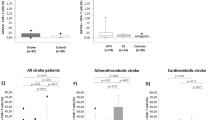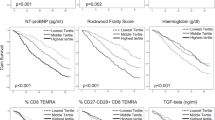Abstract
Although T cells are known to be involved in the pathogenesis of coronary artery disease, it is unclear which subpopulation of T cells contributes to pathogenesis in acute myocardial infarction (MI). We studied the immunological characteristics and clinical impact of CD8+CD57+ T cells in acute MI patients. The frequency of CD57+ cells among CD8+ T cells was examined in peripheral blood sampled the morning after acute MI events. Interestingly, the frequency of CD57+ cells in the CD8+ T-cell population correlated with cardiovascular mortality 6 months after acute MI. The immunological characteristics of CD8+CD57+ T cells were elucidated by surface immunophenotyping, intracellular cytokine staining and flow cytometry. Immunophenotyping revealed that the CD8+CD57+ T cells were activated, senescent T cells with pro-inflammatory and tissue homing properties. Because a high frequency of CD8+CD57+ T cells is associated with short-term cardiovascular mortality in acute MI patients, this specific subset of CD8+ T cells might contribute to acute coronary events via their pro-inflammatory and high cytotoxic capacities. Identification of a pathogenic CD8+ T-cell subset expressing CD57 may offer opportunities for the evaluation and management of acute MI.
This is a preview of subscription content, access via your institution
Access options
Subscribe to this journal
Receive 12 digital issues and online access to articles
$119.00 per year
only $9.92 per issue
Buy this article
- Purchase on Springer Link
- Instant access to full article PDF
Prices may be subject to local taxes which are calculated during checkout



Similar content being viewed by others
References
Hansson GK . Inflammation, atherosclerosis, and coronary artery disease. N Engl J Med 2005; 352: 1685–1695.
Hansson GK, Libby P . The immune response in atherosclerosis: a double-edged sword. Nat Rev Immunol 2006; 6: 508–519.
Hansson GK, Hermansson A . The immune system in atherosclerosis. Nat Immunol 2011; 12: 204–212.
Zhou X, Nicoletti A, Elhage R, Hansson GK . Transfer of CD4+ T cells aggravates atherosclerosis in immunodeficient apolipoprotein E knockout mice. Circulation 2000; 102: 2919–2922.
Song L, Leung C, Schindler C . Lymphocytes are important in early atherosclerosis. J Clin Invest 2001; 108: 251–259.
Huber SA, Sakkinen P, David C, Newell MK, Tracy RP . T helper-cell phenotype regulates atherosclerosis in mice under conditions of mild hypercholesterolemia. Circulation 2001; 103: 2610–2616.
Robertson AK, Hansson GK . T cells in atherogenesis: for better or for worse? Arterioscler Thromb Vasc Biol 2006; 26: 2421–2432.
Liuzzo G, Kopecky SL, Frye RL, O'Fallon WM, Maseri A, Goronzy JJ et al. Perturbation of the T-cell repertoire in patients with unstable angina. Circulation 1999; 100: 2135–2139.
Liuzzo G, Goronzy JJ, Yang H, Kopecky SL, Holmes DR, Frye RL et al. Monoclonal T-cell proliferation and plaque instability in acute coronary syndromes. Circulation 2000; 101: 2883–2888.
Caligiuri G, Paulsson G, Nicoletti A, Maseri A, Hansson GK . Evidence for antigen-driven T-cell response in unstable angina. Circulation 2000; 102: 1114–1119.
Liuzzo G, Biasucci LM, Trotta G, Brugaletta S, Pinnelli M, Digianuario G et al. Unusual CD4+CD28null T lymphocytes and recurrence of acute coronary events. J Am Coll Cardiol 2007; 50: 1450–1458.
Giubilato S, Liuzzo G, Brugaletta S, Pitocco D, Graziani F, Smaldone C et al. Expansion of CD4+CD28null T-lymphocytes in diabetic patients: exploring new pathogenetic mechanisms of increased cardiovascular risk in diabetes mellitus. Eur Heart J 2011; 32: 1214–1226.
Kolbus D, Ljungcrantz I, Andersson L, Hedblad B, Fredrikson GN, Björkbacka H et al. Association between CD8+ T-cell subsets and cardiovascular disease. J Intern Med 2013; 274: 41–51.
Weng NP, Akbar AN, Goronzy JJ . CD28− T cells: their role in the age-associated decline of immune function. Trends Immunol 2009; 30: 306–312.
Focosi D, Bestagno M, Burrone O, Petrini M . CD57+ T lymphocytes and functional immune deficiency. J Leukoc Biol 2010; 87: 107–116.
Vogel M, Kowalewski HJ, Zimmermann H, Janetzko A, Margolis RU, Wollny HE . Association of the HNK-1 epitope with 5′-nucleotidase from Torpedo marmorata (electric ray) electric organ. Biochem J 1991; 278: 199–202.
Brenchley JM, Karandikar NJ, Betts MR, Ambrozak DR, Hill BJ, Crotty LE et al. Expression of CD57 defines replicative senescence and antigen-induced apoptotic death of CD8+ T cells. Blood 2003; 101: 2711–2720.
Maeda T, Yamada H, Nagamine R, Shuto T, Nakashima Y, Hirata G et al. Involvement of CD4+,CD57+ T cells in the disease activity of rheumatoid arthritis. Arthritis Rheum 2002; 46: 379–384.
Palmer BE, Blyveis N, Fontenot AP, Wilson CC . Functional and phenotypic characterization of CD57+CD4+ T cells and their association with HIV-1-induced T cell dysfunction. J Immunol 2005; 175: 8415–8423.
Le Priol Y, Puthier D, Lecureuil C, Combadiere C, Debre P, Nguyen C et al. High cytotoxic and specific migratory potencies of senescent CD8+CD57+ cells in HIV-infected and uninfected individuals. J Immunol 2006; 177: 5145–5154.
Palmer BE, Mack DG, Martin AK, Maier LA, Fontenot AP . CD57 expression correlates with alveolitis severity in subjects with beryllium-induced disease. J Allergy Clin Immunol 2007; 120: 184–191.
Hoffmann J, Fiser K, Weaver J, Dimmick I, Loeher M, Pircher H et al. High-throughput 13-parameter immunophenotyping identifies shifts in the circulating T-cell compartment following reperfusion in patients with acute myocardial infarction. PLoS One 2012; 7: e47155.
Leon MA, Zuckerman S . Gamma interferon: a central mediator in atherosclerosis. Inflamm Res 2005; 54: 395–411.
Johnson JL . Matrix metalloproteinases: influence on smooth muscle cells and atherosclerotic plaque stability. Expert Rev Cardiovasc Ther 2007; 5: 265–282.
Nakajima T, Schulte S, Warrington KJ, Kopecky SL, Frye RL, Goronzy JJ et al. T-cell–mediated lysis of endothelial cells in acute coronary syndromes. Circulation 2002; 105: 570–575.
Gisterå A, Robertson AK, Andersson J, Ketelhuth DF, Ovchinnikova O, Nilsson SK et al. Transforming growth factor-β signaling in T cells promotes stabilization of atherosclerotic plaques through an interleukin-17-dependent pathway. Sci Transl Med 2013; 5: 196ra100.
Posnett DN, Sinha R, Kabak S, Russo C . Clonal populations of T cells in normal elderly humans: the T cell equivalent to “benign monoclonal gammapathy”. J Exp Med 1994; 179: 609–618.
Vallejo AN, Nestel AR, Schirmer M, Weyand CM, Goronzy JJ . Aging-related deficiency of CD28 expression in CD4+ T cells is associated with the loss of gene-specific nuclear factor binding activity. J Biol Chem 1998; 273: 8119–8129.
Merino J, Martinez-Gonzalez M, Rubio M, Inoges S, Sanchez-Ibarrola A, Subira M . Progressive decrease of CD8 high+ CD28+ CD57− cells with ageing. Clin Exp Immunol 1998; 112: 48–51.
Azuma M, Phillips JH, Lanier LL . CD28-T lymphocytes. Antigenic and functional properties. J Immunol 1993; 150: 1147–1159.
Blankenberg S, Tiret L, Bickel C, Peetz D, Cambien F, Meyer J et al. Interleukin-18 is a strong predictor of cardiovascular death in stable and unstable angina. Circulation 2002; 106: 24–30.
Mallat Z, Henry P, Fressonnet R, Alouani S, Scoazec A, Beaufils P et al. Increased plasma concentrations of interleukin-18 in acute coronary syndromes. Heart 2002; 88: 467–469.
Zhang X, Niessner A, Nakajima T, Ma-Krupa W, Kopecky SL, Frye RL et al. Interleukin 12 induces T-cell recruitment into the atherosclerotic plaque. Circ Res 2006; 98: 524–531.
Acknowledgements
This work was supported by the KAIST Future Systems Healthcare Project from the Ministry of Science, ICT & Future Planning of Korea and by the project of Global PhD Fellowship begun by the National Research Foundation of Korea in 2011. This study was also supported by the Korea Healthcare Technology R&D Project, Ministry of Health and Welfare, Republic of Korea (A102065).
Author information
Authors and Affiliations
Ethics declarations
Competing interests
None to declare.
Rights and permissions
About this article
Cite this article
Tae Yu, H., Youn, JC., Lee, J. et al. Characterization of CD8+CD57+ T cells in patients with acute myocardial infarction. Cell Mol Immunol 12, 466–473 (2015). https://doi.org/10.1038/cmi.2014.74
Received:
Revised:
Accepted:
Published:
Issue Date:
DOI: https://doi.org/10.1038/cmi.2014.74
Keywords
This article is cited by
-
Impact of Immunosenescence in Older Kidney Transplant Recipients: Associated Clinical Outcomes and Possible Risk Stratification for Immunosuppression Reduction
Drugs & Aging (2024)
-
Current Scenario and Strategies to Tackle Cardiovascular Disease Risk in HIV Geriatrics
Current Pharmacology Reports (2023)
-
The multifaceted role of the SASP in atherosclerosis: from mechanisms to therapeutic opportunities
Cell & Bioscience (2022)
-
CD100 modulates cytotoxicity of CD8+ T cells in patients with acute myocardial infarction
BMC Immunology (2021)
-
The evolving cardiac lymphatic vasculature in development, repair and regeneration
Nature Reviews Cardiology (2021)



